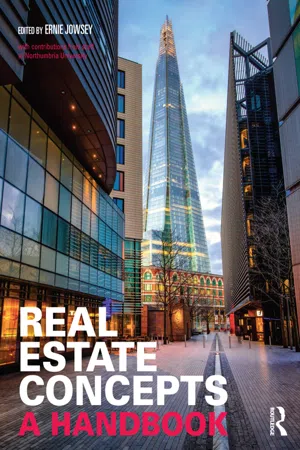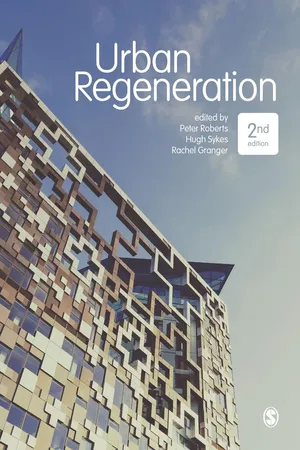Geography
Negative Impacts of Regeneration
Negative impacts of regeneration refer to the adverse effects that can arise from urban renewal projects. These may include displacement of existing communities, loss of affordable housing, and social and cultural disruption. Additionally, regeneration efforts can sometimes lead to gentrification, where rising property values force out lower-income residents, resulting in social inequality.
Written by Perlego with AI-assistance
Related key terms
Related key terms
1 of 4
Related key terms
1 of 3
3 Key excerpts on "Negative Impacts of Regeneration"
- eBook - ePub
Fitting into Place?
Class and Gender Geographies and Temporalities
- Yvette Taylor(Author)
- 2016(Publication Date)
- Routledge(Publisher)
The (mis)management of resources and uneven effects suggests again the vulnerabilities of particular people and places within the logics of regeneration/degeneration. Spatial segregations are renewed rather than seamlessly transformed, where, for example, rural regenerations mean something quite different from urban regeneration – in the case of ex-mining communities this included being ranked as ‘deprived’ and being in receipt of European Social Funds to simply ‘get by’ rather than to get ahead culturally or economically. Regeneration as a policy itself produces spatialised orientations of and for accumulative, ‘active’ citizens as opposed to more ‘pragmatic’ citizens, with the latter often being absented from ideas of ‘city publics’ (Watson 2006, Back 2007): such orientations, as dispositions and feelings, are disproportionately aligned and/or at odds with regional change. Even well-resourced residential and leisure areas were at times positioned as going too far, as material improvements was repositioned as a loss by and for middle-class subjects who could articulate a claim as losing out, being ‘crowded out’ by the wrong kind of ‘influx’; often this middle-class claim was expressed an aesthetic degeneration of their landscapes. This chapter explores the moral and material positions of ‘improvement’ and the proximities and distances that are invoked through, for, and by ‘improving’ people/ places. Distance invokes both time and place and certain geographical locations were viewed as moving too fast, colliding past and present terrain, in becoming something different: such changes were variously perceived as assets or failures in ‘crowding out’ the once protected, authentic, middle-class terrain - eBook - ePub
Real Estate Concepts
A Handbook
- Ernie Jowsey, Ernie Jowsey(Authors)
- 2014(Publication Date)
- Routledge(Publisher)
14 Regeneration Julie Clarke, Hannah Furness, Paul Greenhalgh, Rachel Kirk and David McGuinness 14.1 Defining urban regenerationKey terms: urban regeneration; neighbourhood renewal; area-based initiatives; multiple deprivationRegeneration is a term that is widely misused and misunderstood. It means different things to different people, and can range from large-scale activities that promote economic growth, to neighbourhood interventions that improve people’s quality of life. Fundamentally, it is a holistic process of reversing economic, social and physical decline in areas where market forces alone will not suffice. Holistic regeneration may be conceptualised as a stool, the three legs of which represent physical, economic and social aspects, without any one of which the stool will fall over.Urban regeneration as an idea encapsulates both the perception of a town or city in decline and the hope of renewal, reversing trends in order to find a new basis for economic growth and social well-being. It may be defined as a comprehensive and integrated vision and action that leads to the resolution of urban problems and that seeks to bring about a lasting improvement in the economic, physical, social and environmental condition of an area that has been subject to change (Roberts and Sykes, 2000).Physical regeneration is work on the physical fabric of an area where such work forms part of a strategy to promote social, physical and economic improvements in a given locality, rather than just redevelopment driven solely by market forces (Commission for Racial Equality, 2007). It is necessary to clearly distinguish physical regeneration activity from redevelopment; the latter has arguably been occurring ever since urban settlements existed. It is the process of recycling or reusing land that has already been developed, and may involve demolition, land remediation and reclamation, rebuilding, rehabilitation, conversion and change of use etc. To be considered to be physical regeneration, a project must have some public sector input or intervention that results in it making a contribution beyond the delivery of profitable or worthwhile property development. - eBook - ePub
- Peter Roberts, Hugh Sykes, Rachel Granger, Peter Roberts, Hugh Sykes, Rachel Granger(Authors)
- 2016(Publication Date)
- SAGE Publications Ltd(Publisher)
However, the deterioration of the urban environment is not always associated with economic decline; atmospheric pollution in cities is often an accompanying feature of economic growth and rising prosperity, whilst the urban growth ‘magnets’ in the developing world attract migrants who often live in extremely poor environmental conditions (Roberts et al., 2009). Concern to deal with these and other environmental consequences of urbanisation has grown over the period since the Rio Earth Summit of 1992, and action on the full range of issues has progressed at variable pace. Some of the issues which affect urban regeneration are more advanced than others, including restrictions on certain atmospheric and water pollutants and the protection of species and designated areas, such as Sites of Special Scientific Interest.Urban regeneration has a major role to play in promoting higher environmental standards and the better management of resources. Key issues include the promotion of better urban drainage and flood management, the provision of open space and the use of enhanced design in order to mitigate the effects of climate change (Gill et al., 2007).Chapter 5 provides further information on environmental matters.Changing Urban Policy
So the scene is now set for a brief description and assessment of the evolution of urban policy over the past half century, and for the identification of the sixth and final theme from the past that has influenced the current theory and practice of urban regeneration. This final element reflects the changing assignment of responsibility for the improvement and management of towns and cities. From post-Second World War reconstruction to the present-day model of partnership, power and responsibility for the discharge of the tasks of urban regeneration has changed hands in line with the broader conventions of social organisation and the dominant forces of political life. The pattern of evolution of urban policy, together with the characteristics of each era of policy, is summarised in Table 2.1 .In the immediate period after 1945, repairing wartime damage and reconstructing the fabric of towns and cities, many of which had been neglected for years, initially took priority. This process of reconstruction was seen as a task of national importance. The pace was set by central government, with the Ministry of Town and Country Planning even offering detailed guidance to local authorities ‘on the principles and standards that should govern the preparation of redevelopment plans for (central) areas’ (Ministry of Town and Country Planning, 1947: 1). With detailed prescription of this kind it is little wonder that so many of the end products of the post-war schemes of central renewal look depressingly alike (Hatherley, 2010).
Index pages curate the most relevant extracts from our library of academic textbooks. They’ve been created using an in-house natural language model (NLM), each adding context and meaning to key research topics.
Explore more topic indexes
Explore more topic indexes
1 of 6
Explore more topic indexes
1 of 4


